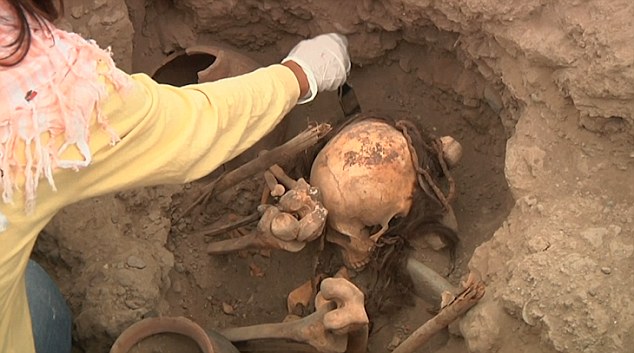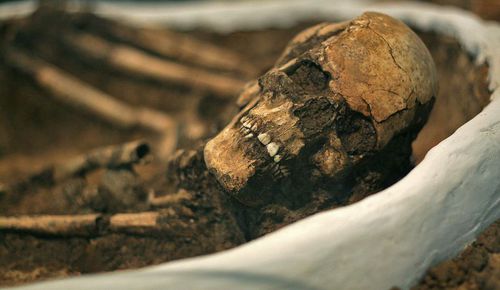1,000-Year-Old Skeletons ‘Wrapped in Textiles’ and ‘Buried in Seated Position’ Looking Out to Sea
The remains of four bodies dating back to 1,000AD have been discovered in a strange sitting position in a series of tombs.
Archaeologists discovered the skeletons of three adult women and one man in the middle of a residential neighbourhood in Lima, Peru
They are part of a civilisation that dominated Peru before the rise of the Inca, and while the remains appear to have decomposed, archaeologists believe they were once wrapped in textiles in an attempt to mummify them.

The four skeletons, which were found in separate tombs, were part of the ancient Ichma culture that formed following the break-up of the South American Wari Empire before later being absorbed into the Inca Empire.
The figures, some of which still have hair, were found seated, looking out towards the sea, alongside offerings such as ceramics and weaving tools. The exact reason for this position is still unclear, but archaeologists believe it must have had some ritual significance. The Incas, and likely cultures before them including the Ichma, believed there was a link between the living and the gods.
Some of the skeletons still have hair and were found buried along with ceramic pots and weaving tools (pictured). While the remains appear to have decomposed, archaeologists believe they were once wrapped in cloth in an attempt to mummify them
As a result, mummies would be ‘consulted’ on important occasions and were often given ‘places of honour’ near temples and on high ground.
The living used artificial techniques such as embalming and drying out the flesh, known as desiccation, to preserve their Dead.
Spanish conquerors during the 16th century were reportedly so disgusted by the ritual that they destroyed many mummies after looting their graves.
This may explain the lack of other artefacts, and even the cloth the mummies were wrapped in, in the newly-discovered tombs.
It is the latest in a number of ancient tombs to be discovered in Peru’s capital, but these are among the first from the Ichma, or Ychsma era, helping to provide new clues about this little-known, early culture.

Isabel Flores, an archaeologist and director of the excavation at Huaca Pucllana, the ancient ceremonial complex in the Miraflores district of Lima where the skeletons were found, said: ‘There are four human burial sites, for adult individuals, three women and one man, who lived between the years 1000 to 1450.
‘These are the first four tombs of the Ichma culture. We think that we may still find more.’
The discovery of the tombs has allowed archaeologists to confirm that the Ichma culture, which dominated the central coast of Peru, had a foothold in Lima.
It dominated the area south of Lima in the Lurin Valley from 1,000AD and later spread north into the Rimac Valley.
It was later absorbed into the Inca Empire in around 1440.
It is known that the Wari culture, which emerged around 600AD, had used the large temple complexes in the area that is now covered by the Peruvian capital.
Archaeologists believe Huaca Pucllana was initially built, however, by the Lima culture who lived there in around 200AD. There are around 350 of these ‘huacas’, or ceremonial complexes in Lima which predate Spanish colonisation.
The Ichma people are credited with constructing at least 16 including the Huaca Huantille in the Magdalena del Mar and the Huaca San Borja in the San Borja District.

In the Huaca Huantille, at least nine mummies have been discovered, buried with ceramic items and jewellery.
Excavations in Pachacamac found a further 80 mummies in a burial chamber. In 2013, the remains of three skeletons from the Ichma culture were uncovered at a nearby site just a few yards from Peru’s national football stadium in Lima.
Dr Flores said: ‘So this is the first district in the country that has more than 1,500 years of known history to date.’
Recently new analysis techniques have enabled scientists to learn new details about the ancient mummified remains of people from the Incan civilisation and those that came before them.
The mummified bodies of children who died around 500 years ago have been discovered in remote parts of the Andes, thought to be victims of an ancient ritual sacrifice called capacocha. The children were drugged before being taken into the mountains to die, where the freezing dry climate preserved their bodies.
